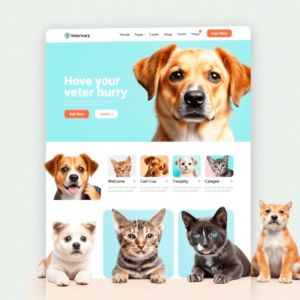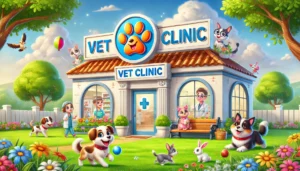Introduction
In today’s digital age, social media strategies for veterinarians have become essential tools. Effective social media strategies are crucial for keeping clients and building brand awareness, changing how veterinarians interact with pet owners. By using different platforms, veterinary practices can share valuable content, encourage community involvement, and advertise their services.
This article explores the Top 5 Social Media Strategies for Veterinary Practices that will help you:
- Engage with pet owners more effectively.
- Share relevant content that resonates with your audience.
- Promote your services and enhance your practice’s visibility.
Discover these strategies to make the most of social media in veterinary care, ensuring a thriving and connected client base. You might also want to consider teaming up with experts like AVI Lead Generation Pets, who specialize in offering complete veterinary marketing services such as website creation, content creation, social media management, paid ads, and reputation management.
1. Choose the Right Platforms for Your Practice
Selecting the appropriate social media platforms is a foundational step in developing an effective online presence for your veterinary practice. Understanding where your target audience spends their time will allow you to allocate resources efficiently and maximize engagement.
Analyzing Your Target Audience
Identify who your primary clients are:
- Millennials and Gen-Z: Predominantly active on platforms like Instagram, Snapchat, and TikTok.
- Pet Parents: Often found on Facebook for community groups, Twitter for real-time updates, and Instagram for visual content.
Knowing these demographics can inform which platforms should be prioritized. For example, if your practice primarily serves young pet owners, focusing on Instagram and TikTok could yield better results compared to LinkedIn or Twitter.
Setting Clear Goals for Each Platform
Define specific objectives tailored to each platform:
- Facebook: Ideal for building community through posts, events, and groups. Aim to increase page likes and post engagement.
- Instagram: Focus on visually appealing content showcasing pets, staff, and behind-the-scenes activities. Goals may include increasing followers and story views.
- Twitter: Use for timely updates, industry news, and quick customer service interactions. Objectives might involve boosting tweet impressions and retweets.
Clarifying these goals helps in measuring success and refining strategies over time.
Examining Competitors
Analyze what similar veterinary practices are doing:
- Review their content types, posting frequency, engagement rates, and follower counts.
- Identify gaps or opportunities where your practice can differentiate itself.
For instance, if competitors are not utilizing Instagram Stories effectively, this could be an area where you can stand out by sharing daily tips or pet care routines.
Testing Different Platforms
Experimentation is key to understanding which channels work best:
- Start with a few platforms based on initial research.
- Monitor performance over a set period using tools like Google Analytics or Hootsuite Insights.
- Assess metrics such as engagement rates, follower growth, and post reach.
By testing different platforms, you can determine which social media channels offer the highest return on investment in terms of client engagement and brand visibility.
Aligning your social media strategy with these insights ensures that efforts are focused where they matter most, leading to more meaningful interactions with pet owners.
2. Foster Community Interaction Through Active Engagement
Maintaining an active presence on social media is crucial for fostering community interaction within your veterinary practice. Engaging with pet owners regularly helps build a loyal community and enhances client retention.
Strategies for Regular Content Posting
Regular content posting is essential to stay visible and relevant. A well-structured social media plan can help streamline this process:
- Frequency: Aim to post at least once daily on platforms like Facebook and Instagram, while Twitter may require multiple posts per day.
- Timing: Analyze when your audience is most active. Tools like Hootsuite can help determine peak engagement times.
- Content Calendar: Develop a monthly content calendar to plan and schedule posts in advance.
Engaging Followers Through Interactive Content
Interaction goes beyond posting content. Engage with your followers actively through various methods:
- Comments and Direct Messages: Respond promptly to comments and direct messages. This shows that you value their input and are attentive to their needs.
- Polls and Q&A Sessions: Utilize interactive features such as polls or Q&A sessions on Instagram Stories or Facebook. These not only engage but also provide insights into what your audience cares about.
- User-Generated Content: Encourage clients to share photos of their pets and feature them on your page, creating a sense of community.
Running Contests or Promotions
Contests and promotions are effective tools for increasing participation and interaction:
- Photo Contests: Host photo contests where clients submit pictures of their pets. Offer a small prize or discount on services for the winner.
- Themed Promotions: Run themed promotions around holidays or pet-related events (e.g., National Pet Day). These can include discounts, giveaways, or special packages.
- Referral Programs: Encourage clients to refer friends by offering incentives like free check-ups or discounted services for successful referrals.
Active engagement not only fosters a sense of community but also keeps your practice top-of-mind for pet owners. Implement these strategies consistently to see substantial growth in your social media presence and client interactions. For more effective engagement, consider using resources that provide insights into creating engaging and effective social media content or explore tips on social media content creation.
3. Tailor Your Content to Meet the Interests of Pet Owners
Tailoring content to meet the interests and needs of pet owners is crucial in creating engaging posts. Understanding what resonates with your audience allows you to craft messages that capture their attention and foster a deeper connection.
Identifying Interests and Needs
Begin by identifying the specific interests and needs of pet owners:
- Health Tips: Share advice on common pet health issues, preventive care, and seasonal concerns.
- Pet Behavior: Offer insights into understanding and managing various pet behaviors.
- Product Recommendations: Highlight products that enhance pet well-being, such as toys, grooming tools, or dietary supplements.
- Local Events: Promote local pet-friendly events or community activities that might interest pet owners.
Successful Audience-Targeted Campaigns
Examples of audience-targeted campaigns include:
- Educational Series: Develop a series of posts around a particular topic, like dental care for pets. Use infographics, videos, and blog links to provide comprehensive information.
- Client Spotlights: Feature stories about pets treated at your practice. This not only showcases your expertise but also builds community by highlighting real-life examples.
- Interactive Content: Create polls or quizzes about pet care preferences. These interactive elements can boost engagement and provide valuable insights into your audience’s interests.
- Seasonal Content: Tailor posts to reflect seasonal changes, such as summer safety tips for pets or winter care recommendations.
Using these strategies ensures that your content remains relevant and engaging for your audience. By focusing on their specific interests and needs, you can foster a stronger connection with pet owners, enhancing both client retention and brand loyalty.
4. Establish a Consistent Brand Voice Across Channels
A strong brand identity is crucial for building trust and credibility among pet owners. When your veterinary practice presents a unified, consistent message across all social media platforms, clients are more likely to recognize and remember your brand. This consistency helps reinforce your practice’s values and personality, making it easier for pet owners to form a connection with you.
How to Maintain Consistency in Messaging
1. Define Your Brand Voice:
Identify the key elements of your practice’s voice. Whether it’s friendly and approachable or professional and authoritative, make sure it aligns with your overall brand identity and resonates with your target audience.
2. Develop a Style Guide:
Create a style guide that outlines language preferences, tone, and visual elements like color schemes and logos. This guide should be referred to whenever new content is developed, ensuring uniformity.
3. Adapt to Platform Nuances:
While maintaining a consistent voice is important, it’s also essential to adjust your messaging to fit the unique characteristics of each platform:
- Facebook: Great for detailed posts, community interaction, and sharing events.
- Instagram: Focus on visual storytelling through images and short videos.
- Twitter: Use concise updates, engaging hashtags, and timely responses.
4. Train Your Team:
Ensure everyone involved in your social media efforts understands the brand voice and follows the style guide. Consistent training can help maintain uniform messaging even when multiple people are managing different platforms.
Practical Tips
- Regular Audits: Periodically review your social media accounts to ensure consistent messaging.
- Feedback Loop: Encourage feedback from clients to understand how they perceive your brand.
- Content Calendar: Plan posts in advance to maintain consistency in topics and timing.
By establishing a consistent brand voice across channels, you reinforce your veterinary practice’s values and enhance recognition among pet owners.
5. Monitor Performance Metrics to Optimize Your Strategy Over Time
Monitoring social media performance is crucial to refining and optimizing your marketing strategies. Tools such as Google Analytics and Hootsuite Insights provide valuable insights into how your content is performing across various platforms. This data helps in making informed decisions, ensuring that your efforts yield the best possible results.
Key Metrics to Track
Understanding which metrics to monitor can significantly impact your social media strategy:
- Engagement Rate: Measures interactions (likes, comments, shares) relative to your follower count. A high engagement rate indicates that your content resonates well with your audience.
- Reach: Tracks the number of unique users who see your content. It helps assess the overall visibility of your posts.
- Impressions: Counts the total number of times your content is displayed, regardless of clicks. This metric can uncover how often your posts appear in users’ feeds.
- Click-Through Rate (CTR): Indicates the percentage of users who click on a link within your post. A higher CTR suggests effective call-to-action and engaging content.
- Follower Growth: Monitors changes in your follower count over time. Consistent growth often reflects successful content and engagement strategies.
Using Google Analytics
Google Analytics offers in-depth analysis of traffic coming to your website from social media channels:
- Traffic Sources Report: Identifies which social platforms are driving the most traffic to your site.
- Behavior Flow Report: Shows the journey of users from social media to different pages on your website, highlighting where they engage or drop off.
Leveraging Hootsuite Insights
Hootsuite Insights provides real-time data and analytics for all connected social media accounts:
- Social Listening: Tracks mentions, keywords, and hashtags relevant to your practice, offering insights into public sentiment and trending topics.
- Post Performance Analysis: Evaluates individual post performance, helping identify which types of content drive the most engagement.
Regularly reviewing these metrics allows you to adapt and refine your strategies, ensuring sustained growth and engagement across all social media platforms.
Additional Strategies for Enhanced Engagement on Social Media Platforms
Leveraging User-Generated Content
User-generated content (UGC) is a powerful tool for building authenticity and trust online. Encourage satisfied clients to share their experiences and photos of their pets on your social media platforms. This not only provides you with valuable content but also showcases real-life testimonials that resonate with potential clients.
Example: Create a hashtag campaign where pet owners post images of their pets using a specific hashtag related to your practice. Feature these posts on your own social media accounts to highlight the community’s involvement and satisfaction.
Behind-the-Scenes Content
Sharing behind-the-scenes glimpses into your practice’s daily operations can humanize your brand and foster a deeper connection with followers. This type of content allows pet owners to see the compassionate care and expertise that goes into every visit.
Examples:
- Daily Routines: Share videos or photos of routine activities such as morning rounds, grooming sessions, or staff meetings.
- Staff Introductions: Highlight team members by sharing their stories, roles, and interests. This personal touch helps build rapport with your audience.
- Facility Tours: Provide virtual tours of your clinic to familiarize clients with the environment.
These strategies create a more engaging and relatable presence on social media, reinforcing trust and loyalty among your clients.
Conclusion: Embrace the Power of Social Media Marketing in Veterinary Care!
Effective marketing techniques for veterinarians are essential in today’s digital landscape. These Top 5 Social Media Strategies for Veterinary Practices provide a comprehensive framework to enhance client engagement, build brand awareness, and promote veterinary services.
Implementing these strategies consistently can lead to significant improvements in your social media presence:
- Choose the Right Platforms: Focus on where your target audience is most active.
- Foster Community Interaction: Maintain an active and engaging presence.
- Tailor Your Content: Ensure it resonates with pet owners’ interests.
- Establish a Consistent Brand Voice: Build trust and credibility.
- Monitor Performance Metrics: Optimize your strategy based on data insights.
Staying open-minded towards emerging trends within this dynamic field will keep your practice ahead of the curve. Embrace these social media strategies for veterinarians, adapt as needed, and watch your veterinary practice thrive online.








